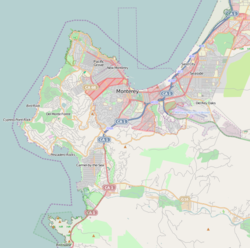
Beacon Hill is a historic neighborhood in Boston, Massachusetts, United States. It is also the location of the Massachusetts State House. The term "Beacon Hill" is used locally as a metonym to refer to the state government or the legislature itself, much like Washington, D.C.'s Capitol Hill does at the federal level.

Westover Plantation is a historic colonial tidewater plantation located on the north bank of the James River in Charles City County, Virginia. Established in c. 1730–1750, it is the homestead of the Byrd family of Virginia. State Route 5, a scenic byway, runs east–west to the north of the plantation, connecting the independent cities of Richmond and Williamsburg.
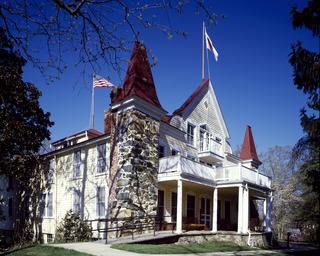
The Clara Barton National Historic Site, which includes the Clara Barton House, was established in 1974 to interpret the life of Clara Barton (1821–1912), an American pioneer teacher, nurse, and humanitarian who was the founder of the American Red Cross. The site is located 2 miles (3.2 km) northwest of Washington D.C. in Glen Echo, Maryland.

Monterey State Historic Park is a historic state park in Monterey, California. It includes part or all of the Monterey Old Town Historic District, a historic district that includes 17 contributing buildings and was declared a National Historic Landmark in 1970. The grounds include California's first theatre, and the Monterey Custom House, where the American flag was first raised over California.

The Cathedral of San Carlos Borromeo, also known as the Royal Presidio Chapel, is a Catholic cathedral located in Monterey, California, United States. The cathedral is the oldest continuously operating parish and the oldest stone building in California. It was built in 1791-94 making it the oldest serving cathedral in the United States, along with St. Louis Cathedral in New Orleans, Louisiana. It is the only existing presidio chapel in California and the only existing building in the original Monterey Presidio.

The Oregon Caves Chateau is a historic American hotel that opened in 1934. It is located in Oregon Caves National Monument in southern Oregon, near Cave Junction. The Chateau was designed and built by Gust Lium, a local contractor. Declared a National Historic Landmark in 1987, the Chateau building is architecturally significant because of its construction and design. The Chateau is closed for repairs until further notice.

The José Castro House, sometimes known as the Castro-Breen Adobe, is a historic adobe home in San Juan Bautista, California, facing the Plaza de San Juan. The Monterey Colonial style house was built 1838-41 by General José Antonio Castro, a former Governor of Alta California. It was later sold to the Breen family, who lived there until 1933, when the house became a museum as part of San Juan Bautista State Historic Park.

San Juan Bautista State Historic Park is a California state park encompassing the historic center of San Juan Bautista, California, United States. It preserves a significant concentration of buildings dating to California's period of Spanish and Mexican control. It includes the Plaza Hotel, the José Castro House, and several other buildings facing the historic plaza. It became a state park in 1933.

The Hill–Physick–Keith House, also known as the Hill–Keith–Physick House, the Hill–Physick House, or simply the Physick House, is a historic house museum located at 321 S. 4th Street in the Society Hill neighborhood of Philadelphia, Pennsylvania, USA. Built 1786, it was the home of Philip Syng Physick (1768–1837), who has been called "the father of American surgery". The house was declared a National Historic Landmark in 1976. It is now owned and operated by the Philadelphia Society for the Preservation of Landmarks as a house museum.

The Larkin House is a historic house at 464 Calle Principal in Monterey, California. Built in 1835 by Thomas O. Larkin, it is claimed to be the first two-story house in all of California, with a design combining Spanish Colonial building methods with New England architectural features to create the popular Monterey Colonial style of architecture. The Larkin House is both a National and a California Historical Landmark, and is a featured property of Monterey State Historic Park.
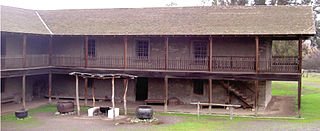
Monterey Colonial is an architectural style developed in Alta California. Although usually categorized as a sub-style of Spanish Colonial style, the Monterey style is native to the post-colonial Mexican era of Alta California. Creators of the Monterey style were mostly recent immigrants from New England states of the US, who brought familiar vernacular building styles and methods with them to California.

The Old Custom House is the oldest surviving government building in California, built in 1827 by Mexican authorities in Monterey, then the capital of Alta California. The former custom house is the first designated California Historical Landmark, marking the site where U.S. Commodore John Drake Sloat raised the American flag and declared California part of the United States in 1846 during the American Conquest of California.

This is a list of the National Register of Historic Places listings in Monterey County, California.
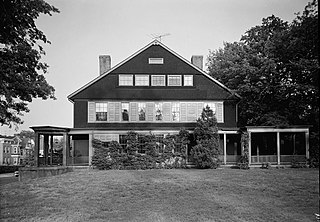
The Atwater–Ciampolini House, also known as the Charles Atwater House, is located at 321 Whitney Avenue in New Haven, Connecticut, at the southwest corner of intersection with Edwards Street. It is an important example of Shingle style architecture. It was designed by New York City-based architects Babb, Cook and Willard and was built during 1890-92. For many years the property had served as offices for Thompson and Peck, an insurance agency.

The Architecture of Buffalo, New York, particularly the buildings constructed between the American Civil War and the Great Depression, is said to have created a new, distinctly American form of architecture and to have influenced design throughout the world.

The Hamburg Historic District, also known as the Gold Coast, is a residential neighborhood located on a bluff northwest of downtown Davenport, Iowa, United States. It is listed on the National Register of Historic Places in 1983. In 1999, it was listed on the Davenport Register of Historic Properties The historic district is where the city's middle and upper-income German community built their homes in the 19th and early 20th centuries. Germans were the largest ethnic group to settle in Davenport.
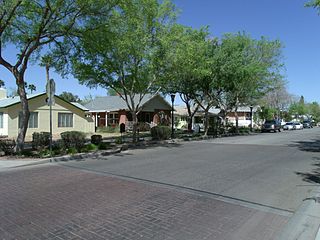
The Catlin Court Historic District, established in 1914, is significant for its historic association with an important period in the development of the city of Glendale, Arizona, United States.

The Stevenson House, is a historic two-story Spanish Colonial style building located at 530 Houston Street in Monterey, California. It was a boarding house called the French Hotel, built circa 1836. The Scottish author Robert Louis Stevenson lived there in 1879, writing and courting his future wife. It is now a museum and property of the Monterey State Historic Park. The building was listed on the National Register of Historic Places on January 7, 1972. The building is also listed as a California historical landmark #352.

The Simon Van Duyne House is a historic house located at 58 Maple Avenue in the Pine Brook section of the township of Montville in Morris County, New Jersey. The oldest section was built c. 1750. It was documented by the Historic American Buildings Survey in 1936. The house was later added to the National Register of Historic Places on January 17, 1992, for its significance in architecture. The house was also listed as part of the Dutch Stone Houses in Montville, New Jersey Multiple Property Submission (MPS).

